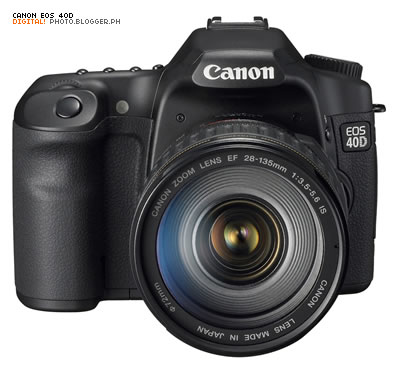
Looking for a hands-on review on the Canon EOS-40D? We found two reviews to give you the lowdown on Canon’s new model.
- Canon EOS-40D: A Hands-On Report
My time with the 40D was short, but I found that shooting about a thousand frames over a long weekend was all I needed to be able to draw some preliminary conclusions. These are, in brief, that the image quality of the 40D is excellent, continuing the industry-leading results that Canon has offered for the past 5-6 years. I didn’t see any breakthrough in low noise at the highest ISOs, but as with the EOS 5D ISO 400 is essentially noiseless and can be used as an everyday speed. Noise doesn’t really become an issue until ISO 1600 and even then isn’t that objectionable.
I’m sure that once the major camera testing sites have done their thing there will be lots of charts and graphs to validate this perspective, so if these turn your crank, wait for them. In the meantime, I find that the IQ of the 40D is on a par if not even slightly better than that of the Canon 5D, which up until now has been my benchmark for DSLR image quality both at low and at high ISO.
The bottom line is that the Canon 40D is the most DSLR for the money that Canon has ever offered. Certainly in its price range there doesn’t seem to be anything that can touch it. Move up a notch in price though and the forthcoming Nikon D300 may well put the squeeze on Canon’s hegemony in the DSLR marketplace. Time will tell, and no matter what happens we’ll all benefit from the renewed competition.
- Canon 40D image quality shootout
The conventional wisdom is that full frame SLRs will always produce the highest IQ. APS-C cameras while good, just can’t match full frame sensors. With the exception of the Nikon D2X which is pretty much the equal of full frame SLR’s at ISO 100, I’ve never seen a camera break with this wisdom. The D2X was until recently the Nikon flagship camera and costs about $4500. The IQ I see in the 40D images from ISO 100-800 is 95% the match of the 5D. At 1600 the shadow noise of the 5D looks to be a tad bit better than the 40D, but not by a large margin. The 40D’s tonality and richness in color gives the 5D a real run for the money. The only area I see the 5D looking better is in low contrast highlight regions. It manages to pull out a tad more detail. The 20D does okay in the shadows, but in the midtones and highlights just can’t match the richness of the 5D or 40D. It’s images while pretty good have a flatter tonal appearance. This subtle richness gives the 5D images the 3D effect people often talk about.
Read them well before you bite on that itch to upgrade. ;)